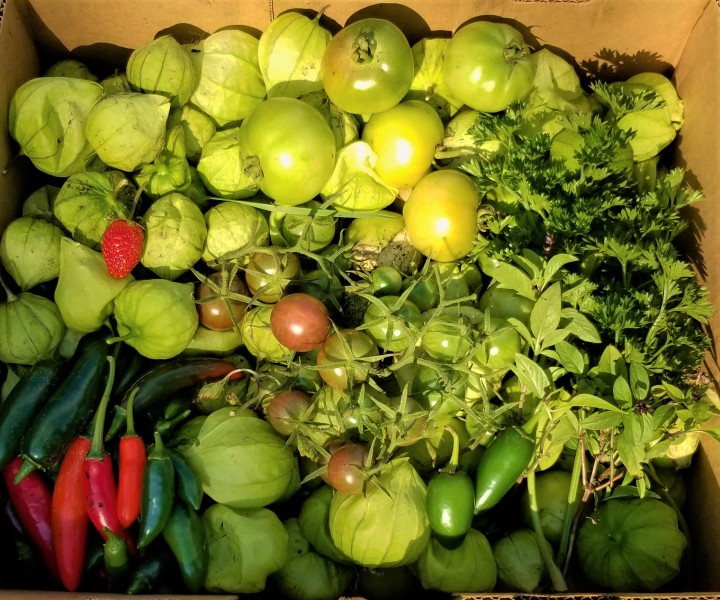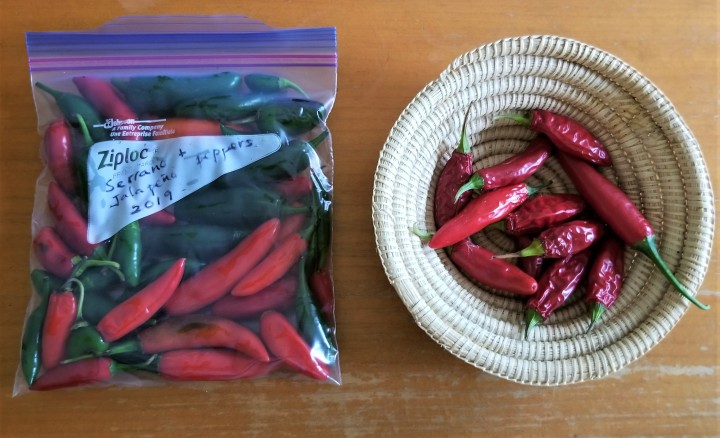
The picture above shows a box with one of my recent backyard harvests (bumper crop of tomatillos, a few tomatoes, serrano and jalapeño peppers, black cherry tomatoes, parsley, Thai basil and even one strawberry!)
It might sound like a platitude to remark that produce harvested at dawn should be consumed or processed before the end of the day, to make the best of its nutrients, but in this case, I really had to do it since I will be going away to Mexico in a couple of days.
The strawberry was washed and promptly eaten (it was sweet!), and the few ripe black cherry tomatoes and the herbs were used in a fresh salad.
Tomatillos, also known as husk tomatoes (Physalis philadelphica and Physalis ixocarpa), are sometimes confused with green (unripe) tomatoes (Solanum lycopersicum); although in the same botanical family (Solanaceae), they are different species. Green tomatoes may be fried, pickled, or placed in paper bags in a single layer and left to ripen in a cool room (photo below, left); depending on the variety, they will turn red, brown, orange, yellow or sometimes even a different shade of green, and to eat raw, they are at their best when fully ripened. For tomatillos, first the husks must be discarded, and the fruit rinsed to remove its sticky coating; tomatillos may be green or a chic purple colour, and are used when still under-ripened, since they tend to turn pale and lose a lot of flavour as they mature. Raw tomatillo salsa is delicious and I always make sure I prepare a couple of batches with freshly picked tomatillos; for the rest, I either make a large batch of cooked salsa and bottle it, or pack single layers of tomatillos in freezer bags, removing as much air as possible (I use a straw, as shown below, as I squeeze the bag, then remove the straw and seal the bag completely). This way, they will keep for up to one year in the freezer, and may be boiled from frozen whenever a cooked green sauce is needed:

Last, but not least, there was a bunch of serrano and jalapeño peppers, at different stages of maturity, from dark green, to orange and red, with some already drying and shrinking:

I washed and dried all the peppers, and saved a few of the firm green and red to suit just this week’s needs in the kitchen; I separated the rest, placing the firm ones in a freezer bag (same trick with the straw to get more air out) and the wrinkled ones in a basket to have handy, on the counter:

I am going to be in Mexico for the next two weeks, to see my family and attend one of my niece’s wedding! I have scheduled some new and old posts to be published during my absence, so please continue to visit my website and feel free to comment; I will catch up as soon as I return!
I am sharing my still life images at Cee’s Flower of the Day (FOTD) Challenge for October 10, 2019.








I enjoyed hearing about your tomatillos, Irene. I’ve never come across them before. What a bountiful harvest. I am very impressed.
Have a great trip back to your other home. Look forward to hearing about it. No doubt you will sneak in a couple of wedding photos. 🙂
LikeLiked by 1 person
Thank you, Tracy! Yeah, hopefully my niece and nephew-in-law will not mind 😊
LikeLiked by 1 person
And photos of the wedding food too please. 🙂
LikeLiked by 1 person
Yeah, I am curious about that, too!
LikeLiked by 1 person
Have a great trip. Hope you have sunshine and are surrounded by love and beauty!
LikeLike
Thank you, Victoria!
LikeLike
Wonderful entry for today 😀 Thanks for playing.
LikeLiked by 1 person
I’m a big fan of tomatillos and I still find it funny when people think they are green tomatoes. Green tomatoes are very popular, here in the South.
LikeLiked by 1 person
Yes, and in Mexico tomatoes ripen very fast so there are no green tomato recipes. Until a few years back, I thought “fried green tomatoes” was just a movie title.
LikeLike
It’s a really good movie! I might put up a post about fried green tomatoes…they are very sweet, very southern, and very fried. 🙂
LikeLiked by 1 person
Looking forward to reading your post!
LikeLike
Your harvest looks great and tasty! I didn’t know that paper bags can be used to ripen vegetables. and looking forward to hearing about your trip to Mexico when you get back.
LikeLiked by 1 person
Your harvest is so wonderful and encouraging, Irene. Good tips on what’s freezable also. Have a wonderful time in Mexico and I’m sure it will be a good time at the gathering for your niece’s wedding. Bon voyage!
LikeLike
Thank you, MsJadeLi
LikeLiked by 1 person
You’re welcome.
LikeLiked by 1 person